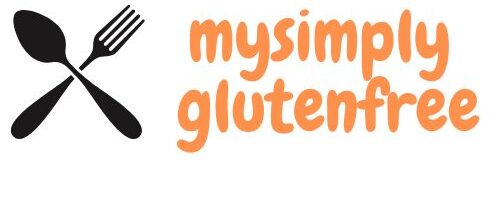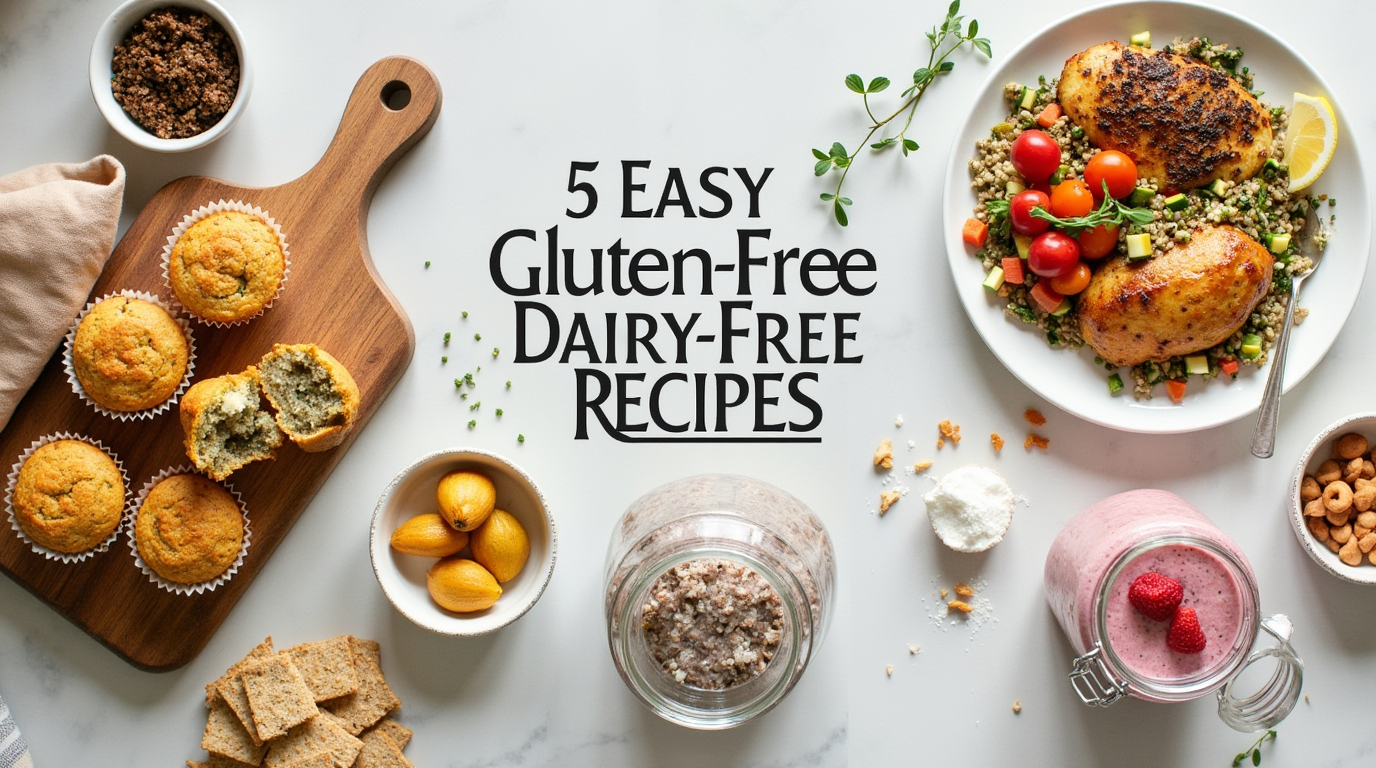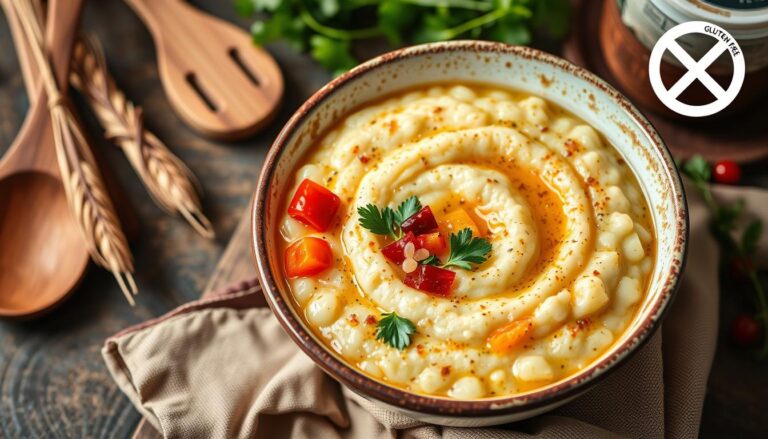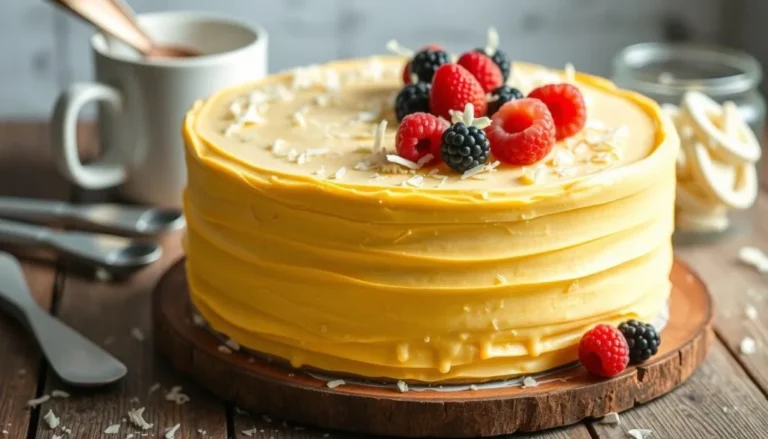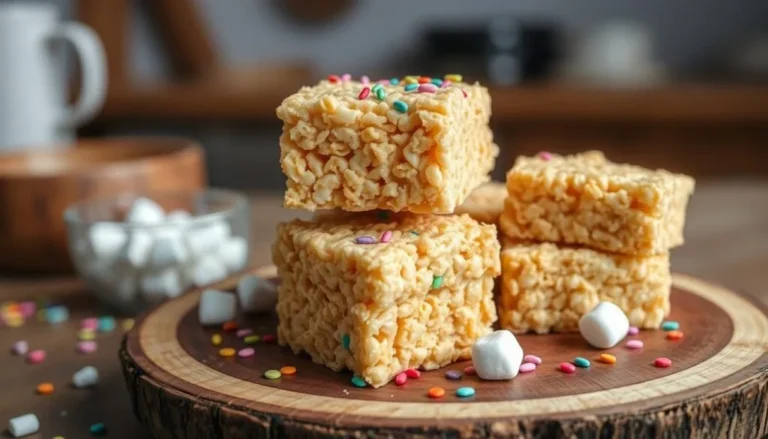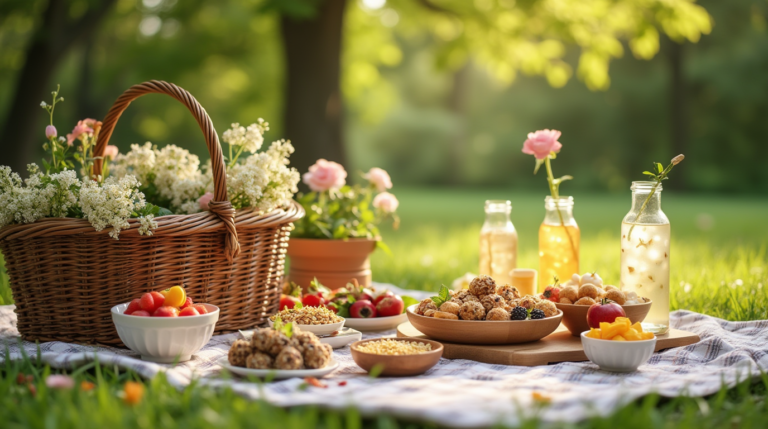5 Easy Gluten-Free Dairy-Free sugar-free Recipes for Beginners
Starting a gluten-free, dairy-free, and sugar-free diet can seem daunting. I once felt lost in the kitchen, unsure if tasty meals were possible. But, the truth is, delicious meals are not only possible but also great for your health.
These recipes are here to help you transition smoothly. They’re perfect if you’re dealing with food sensitivities, looking for healthier options, or just curious about new cooking methods. You’ll see that cutting out gluten, dairy, and sugar doesn’t mean missing out on taste or nutrition.
Our selection of 5 easy gluten-Free dairy-Free sugar-free recipes shows that healthy eating is both easy and tasty. You’ll find recipes for every meal, including breakfast, dinner, and even desserts. You’ll learn how to make meals that are good for you and enjoyable to eat.
Table of Contents
Understanding Dietary Restrictions and Benefits
Exploring gluten and dairy free meals can seem daunting at first. Many people avoid certain foods to boost their health and tackle specific health issues. Knowing why you make these choices helps you make tasty, healthy recipes.
Health Benefits of Eliminating Ingredients
Removing gluten, dairy, and sugar can bring many health benefits:
- Less inflammation in the body
- Better digestion
- More energy
- Help with weight control
- Relief from autoimmune issues
“Food is the most powerful medicine when chosen wisely” – Hippocrates
Common Ingredients to Avoid
When cooking gluten and dairy free meals, be careful of these ingredients:
- Wheat and gluten-containing grains
- Milk products like cheese and butter
- Refined sugars and artificial sweeteners
- Processed foods with hidden allergens
Recommended Substitutions
Smart swaps make gluten-free dairy-free sugar-free recipes easy:
- Almond or coconut milk instead of dairy milk
- Coconut flour or almond flour for wheat flour
- Maple syrup or stevia as natural sweeteners
- Nutritional yeast for cheesy flavor
Understanding these dietary restrictions helps you make healthy, tasty meals that support your health goals.
Essential Pantry Staples for Gluten-Free Dairy-Free Sugar-Free Recipes
Having a well-stocked pantry is key for making tasty gluten-free dairy-free sugar-free dishes. Your kitchen should have versatile ingredients for easy and healthy cooking.
Having the right ingredients makes cooking gluten-free dairy-free sugar-free recipes easy. Focus on these main categories:
- Gluten-Free Flours
- Almond flour
- Coconut flour
- Rice flour
- Cassava flour
- Dairy Alternatives
- Almond milk
- Coconut milk
- Cashew cream
- Nutritional yeast
- Natural Sweeteners
- Stevia
- Monk fruit extract
- Coconut sugar
- Pure maple syrup
Pro tip: Always check labels to ensure ingredients are certified gluten-free and free from hidden dairy components.
“A well-prepared pantry is the foundation of successful dietary restriction cooking.” – Nutrition Expert
| Ingredient Category | Key Alternatives | Nutritional Benefits |
|---|---|---|
| Flour Substitutes | Almond, Coconut, Quinoa | High protein, Low carb |
| Milk Alternatives | Almond, Oat, Coconut | Calcium-rich, Lactose-free |
| Sweeteners | Stevia, Monk Fruit | Zero calories, Natural |
With these pantry staples, you’ll be set to make incredible gluten-free dairy-free sugar-free recipes with confidence.
Kitchen Tools and Equipment You’ll Need
Preparing gluten-free dairy-free sugar-free recipes needs the right tools. With the right kitchen arsenal, cooking becomes easier and more fun. Tools that make working with alternative ingredients a breeze are key.

Starting a specialized diet doesn’t limit your cooking creativity. The right equipment can make your gluten-free dairy-free sugar-free recipes enjoyable. It turns a challenge into a delight.
Basic Equipment Essentials
- High-quality mixing bowls in multiple sizes
- Accurate digital kitchen scale
- Reliable food processor
- Versatile blender
- Measuring cups and spoons
Specialized Tools for Better Results
Improve your gluten-free dairy-free sugar-free cooking with these tools:
- Spiralizer for vegetable noodles
- High-speed blender for nut milks
- Silicone baking mats
- Grain mill for alternative flours
Storage Solutions
| Storage Type | Purpose | Recommended Brands |
|---|---|---|
| Airtight Container Set | Preserve alternative flours | OXO Good Grips |
| Glass Storage Jars | Store nuts and seeds | Bormioli Rocco |
| Vacuum Sealer | Extended ingredient freshness | FoodSaver |
“Invest in quality tools, and your gluten-free dairy-free sugar-free recipes will thank you!” – Professional Chef
With these essential kitchen tools, you’re ready to make delicious and healthy meals. They meet your dietary needs perfectly.
Breakfast Options: Grain-Free Morning Glory Muffins
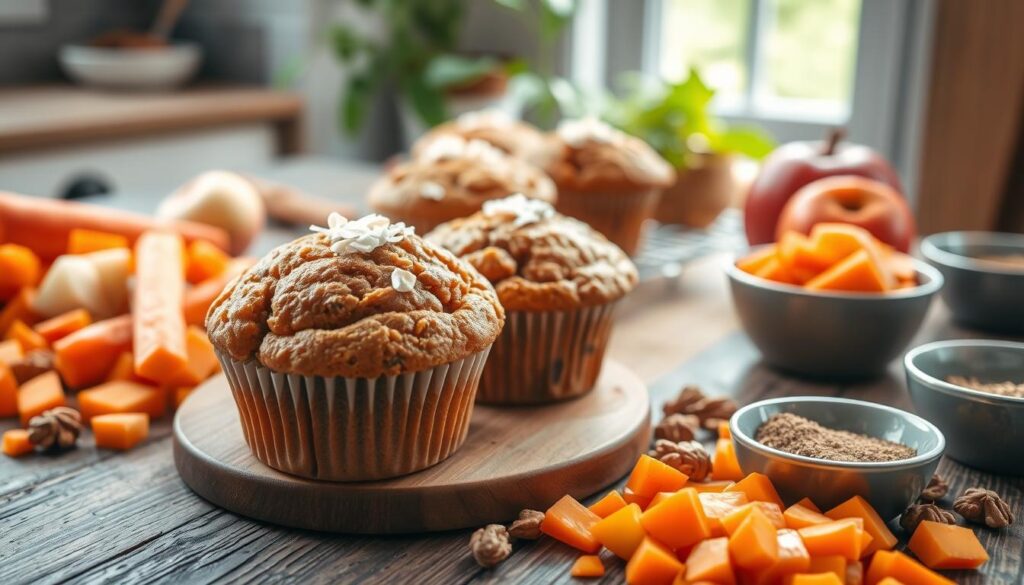
Start your day with a tasty breakfast that fits your dietary needs. These morning glory muffins are perfect for those who follow gluten and dairy free meals. They’re both nutritious and delicious.
To make the best grain-free muffin, you need to choose the right ingredients. Almond flour is a great choice. It’s packed with protein and has a nutty flavor that goes well with other ingredients.
Key Ingredients for Success:
- Almond flour (primary flour substitute)
- Grated carrots
- Shredded coconut
- Chopped apples
- Eggs (binding agent)
Nutritional Breakdown of Ingredients:
| Ingredient | Nutritional Benefit | Quantity |
|---|---|---|
| Almond Flour | High Protein, Low Carb | 2 cups |
| Carrots | Vitamin A, Fiber | 1 cup |
| Coconut | Healthy Fats | 1/2 cup |
“Eating healthy doesn’t mean sacrificing taste – it means being creative with ingredients!” – Nutrition Expert
These morning glory muffins are a great choice for gluten-free dairy-free sugar-free recipes. They’re not just a meal; they’re a nutritional powerhouse that keeps you full all morning.
Pro tip: Keep these muffins in an airtight container for up to 5 days. They’re perfect for meal prep. You can also freeze them for longer, so you always have a healthy breakfast ready.
Quick and Easy Lunch Ideas: Mediterranean Quinoa Bowl
Discovering tasty gluten-free and dairy-free recipes can change your meal planning. The Mediterranean Quinoa Bowl is a great lunch choice. It meets dietary needs and offers amazing flavor and nutrition.
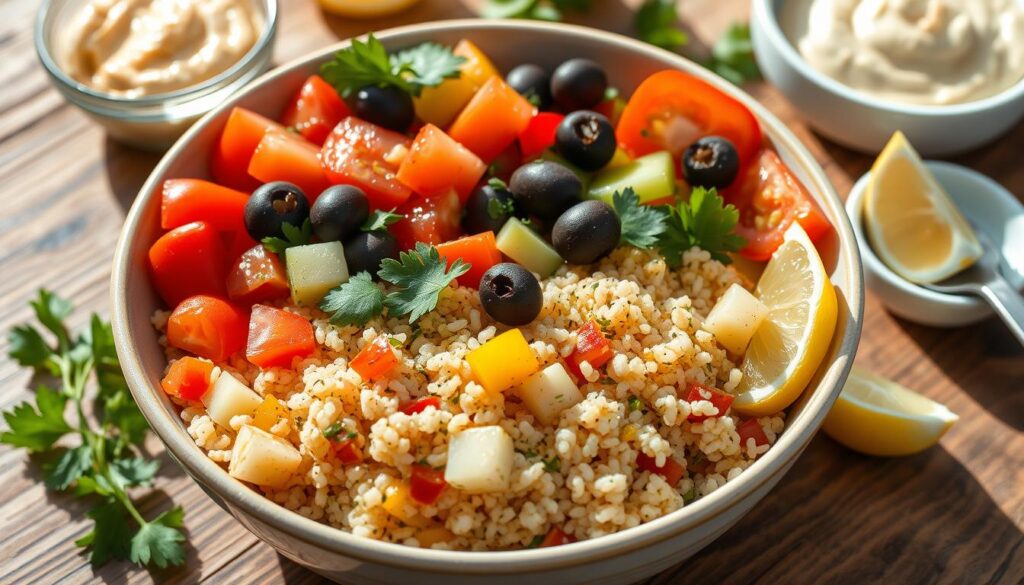
This vibrant recipe is packed with nutrients. Quinoa is a great protein source that fits gluten-free meals perfectly.
Ingredient Selection
- Organic quinoa
- Fresh Mediterranean vegetables
- Extra virgin olive oil
- Herb blend (parsley, mint, oregano)
- Lemon juice
Preparation Tips
Making your Mediterranean Quinoa Bowl is easy. First, rinse quinoa well to remove bitterness. Then, cook it in vegetable broth for extra flavor.
“Meal preparation is about creating delicious, nutritious food that supports your dietary needs.” – Nutrition Expert
Storage and Meal Prep Guidelines
Batch cooking this recipe saves time. Store it in airtight containers, keeping veggies and dressing separate. This way, it stays fresh for 3-4 days in the fridge.
Serving Suggestions
Add grilled chicken or chickpeas for extra protein. A drizzle of tahini or homemade vinaigrette can change the taste. This makes each meal feel new and exciting.
Pro tip: Roast vegetables in advance to reduce preparation time during busy weekdays.
Hearty Dinner Solutions: Herb-Roasted Chicken with Vegetables see
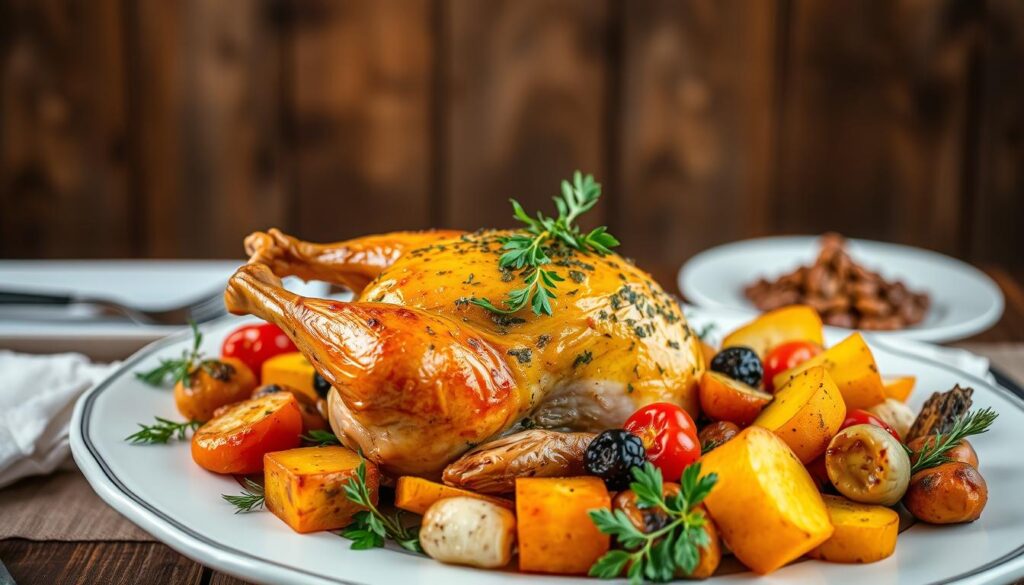
Making a tasty gluten dairy free dinner is easy. This herb-roasted chicken recipe turns a simple protein into a delicious meal. It meets dietary needs without losing flavor.
Creating a gluten and dairy free meal needs careful ingredient picking and smart cooking. The secret to a great roasted chicken is using top-quality ingredients and mastering roasting.
“Great meals are about quality ingredients and confident cooking,” says renowned chef Maria Rodriguez.
- Select organic, free-range chicken for best results
- Use fresh herbs like rosemary, thyme, and sage
- Choose olive oil as your primary cooking fat
- Incorporate colorful seasonal vegetables
Your herb-roasted chicken will have a crispy outside and soft inside. Marinate the chicken in olive oil, garlic, and fresh herbs for extra flavor. Add root veggies like carrots, parsnips, and sweet potatoes for a full meal.
For perfect results, pat the chicken dry before seasoning. Use a meat thermometer to check the internal temperature. Let the chicken rest before carving.
Cooking without gluten or dairy doesn’t mean compromising on taste or nutrition.
Leftovers can be turned into salads, wraps, or quick lunches. This makes the gluten dairy free dinner a great choice for meal prep in busy families.
Healthy Snack Alternatives: Energy Bites and Crackers
Exploring gluten-free dairy-free sugar-free recipes can change your snacking game. It’s not hard to find tasty, healthy options that fit your dietary needs.
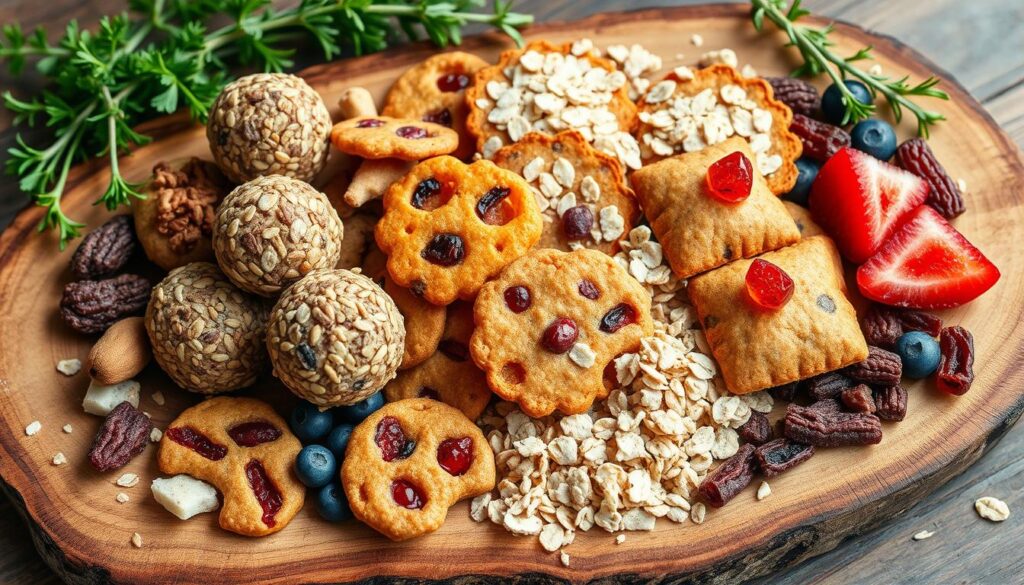
Snacks are key for keeping your energy up and hunger in check. The right snacks can greatly improve your nutrition.
Raw Energy Ball Options
Energy balls are great for quick, healthy snacks. Here are some tasty options:
- Almond Coconut Balls
- Cacao Date Bites
- Chia Seed Energy Balls
These energy balls are full of nutrients and taste amazing. They keep you full and give you energy.
Savory Cracker Variations
Crackers can be tough to find when you’re watching your diet. But making your own is easy and lets you control what goes in.
| Cracker Type | Key Ingredients | Preparation Time |
|---|---|---|
| Flaxseed Crackers | Ground flaxseeds, herbs, salt | 25 minutes |
| Zucchini Crackers | Shredded zucchini, almond flour | 35 minutes |
| Seed Crackers | Mixed seeds, nutritional yeast | 30 minutes |
“Healthy snacking is about creating delicious alternatives that nourish your body and satisfy your taste buds.” – Nutrition Expert
Simple Dessert Ideas: Berry Chia Pudding
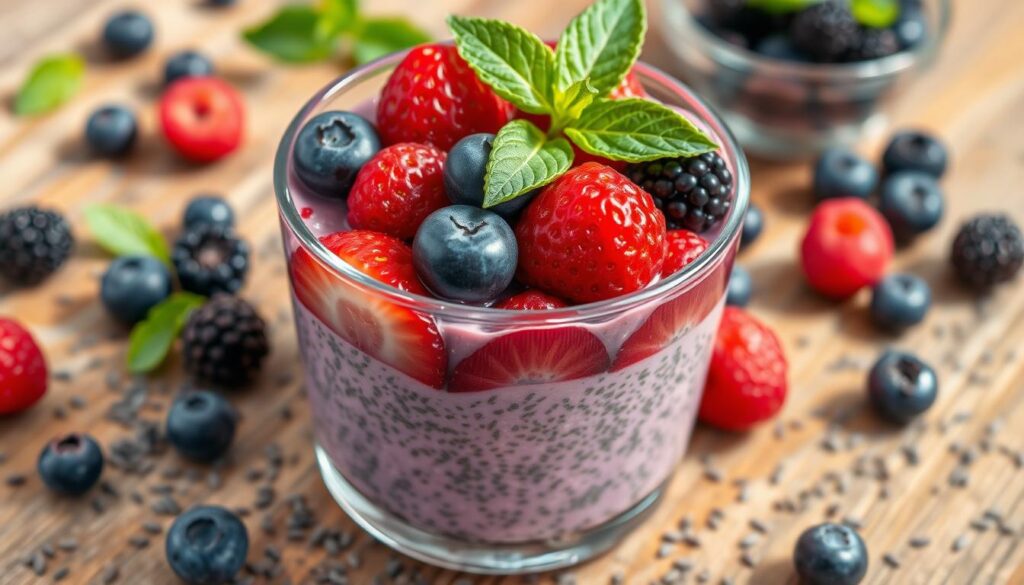
Looking for a tasty gluten free sugar free dessert? Berry chia pudding is the answer! It’s a creamy, delightful treat that’s both nutritious and satisfying.
“Healthy desserts can be both delicious and nourishing!” – Nutrition Experts
Chia seeds are an excellent source of omega-3 fatty acids, fiber, and protein. Mix them with plant-based milk and fresh berries for a magical dessert. It supports your dietary goals.
Key Ingredients
- Organic chia seeds
- Unsweetened almond milk
- Mixed berries (strawberries, blueberries, raspberries)
- Natural sweeteners like stevia or monk fruit
Preparation Steps
- Mix chia seeds with plant-based milk
- Let mixture sit for 2-3 hours
- Top with fresh berries
- Optional: Add natural sweetener
| Nutrient | Amount per Serving |
|---|---|
| Calories | 120 |
| Protein | 5g |
| Fiber | 10g |
| Omega-3 | 4.5g |
Your berry chia pudding is a guilt-free dessert. It fits perfectly with gluten free sugar free desserts. Try different berries and toppings to keep it exciting!
Meal Planning and Prep Strategies
Planning meals for gluten free dairy free recipes is key. It keeps you on track and makes cooking fun and easy.
Start by knowing what you need nutritionally. Then, plan your cooking in a smart way. This turns your kitchen into a place where gluten and dairy free meals are easy to make.
Weekly Shopping List Essentials
Your shopping list should have ingredients that fit your gluten free dairy free recipes. Choose whole foods that are nutritious and versatile.
- Fresh produce (vegetables and fruits)
- Lean proteins (chicken, fish, tofu)
- Grain alternatives (quinoa, rice, buckwheat)
- Plant-based milk substitutes
- Nuts and seeds
Batch Cooking Strategies
Batch cooking is a big help for keeping your meals consistent. Spend a few hours each week cooking meals ahead of time.
| Cooking Strategy | Time Saved | Meal Variety |
|---|---|---|
| Protein Preparation | 2-3 hours | Grilled chicken, roasted tofu |
| Grain Batch Cooking | 1 hour | Quinoa, brown rice |
| Vegetable Roasting | 45 minutes | Mixed vegetable medley |
Pro tip: Invest in quality storage containers to keep your batch-cooked meals fresh and organized.
“Preparation is the key to maintaining a healthy, delicious gluten and dairy free lifestyle.”
With these strategies, cooking becomes simpler. You’ll always have healthy, tasty meals ready to go.
Common Recipe Mistakes to Avoid
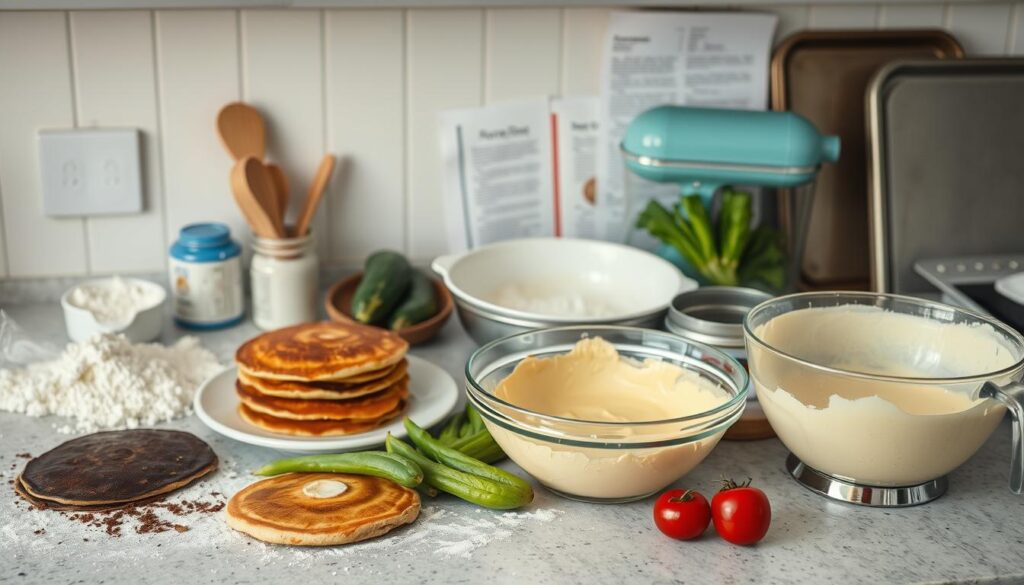
Starting with gluten free dairy free sugar free recipes can be tough. Many beginners face specific problems that can ruin their dishes. Knowing these common mistakes will help you make tasty and successful meals for special diets.
- Improper Flour Measurements: Gluten-free flours act differently than regular wheat flour. Always measure carefully and weigh ingredients when you can.
- Overlooking Cross-Contamination: Make sure your kitchen tools and surfaces are free from gluten to keep your recipes right.
- Incorrect Liquid Ratios: Dairy-free recipes often need different liquid amounts to get the right texture.
Finding the right substitutes is key for dairy gluten free recipes. Not all alternative ingredients work the same, so it’s important to research and try different things.
“Cooking is about precision, especially when working with specialized dietary recipes.” – Professional Chef
| Common Mistake | Potential Solution |
|---|---|
| Over-mixing batters | Mix until ingredients are just combined |
| Ignoring binding agents | Use xanthan gum or ground flaxseed |
| Skipping ingredient testing | Always sample alternative ingredients before full recipe preparation |
Reading labels carefully can help avoid unwanted ingredients. Many products have hidden gluten, dairy, or sugar. Learn about different names and derivatives to make better choices.
- Check ingredient lists carefully
- Look for certified gluten-free labels
- Understand alternative ingredient names
By avoiding these common mistakes, you’ll get better at making delicious gluten free dairy free sugar free recipes. These recipes will meet both dietary needs and taste buds.
Tips for Success with Alternative Ingredients
Working with gluten-free dairy-free sugar-free recipes can be tough. But, with the right tips, you can make tasty meals that fit your diet. Learning to swap out ingredients is crucial for making gluten-free sugar-free desserts and more.
Getting good at using alternative ingredients takes time and effort. Here are some key strategies to improve your cooking skills.
Flour Substitutions Guide
Choosing the right flour is key in gluten-free dairy-free sugar-free recipes. Each flour has its own special qualities:
- Almond flour: High in protein, perfect for baking
- Coconut flour: Soaks up a lot of liquid, needs extra eggs
- Cassava flour: Most like wheat flour in texture
- Chickpea flour: Great for savory dishes
Natural Sweetener Options
You don’t have to give up flavor when cutting sugar in your gluten-free sugar-free desserts. Try these natural sweeteners:
- Stevia: Zero calories, very sweet
- Monk fruit: Natural, no bitter taste
- Erythritol: Low-calorie sugar substitute
- Coconut sugar: Has a lower glycemic index
Dairy Alternative Recommendations
Dairy-free cooking is easier than ever with these versatile options:
- Coconut milk: Creamy, ideal for baking
- Almond milk: Light, neutral taste
- Oat milk: Most like cow’s milk in texture
- Cashew cream: Great for sauces
“The secret to great alternative cooking is experimentation and understanding each ingredient’s unique properties.” – Culinary Expert
Try out these alternatives and turn your gluten-free dairy-free sugar-free recipes into amazing dishes!
Conclusion
Starting a gluten free dairy free sugar free recipe journey might seem hard at first. But now, you know it’s doable. This guide shows that healthy eating can be tasty and fulfilling.
By learning about different ingredients and simple cooking, you can change how you eat. You’ll feel more confident in making gluten and dairy free meals.
Your kitchen is ready to make delicious dishes that fit your diet. Each recipe is a step towards better nutrition. Remember, being flexible is important. Feel free to try new things and make recipes your own.
Nutrition is a personal journey, and these recipes are a great start. They help you explore a healthier lifestyle. Whether you have food sensitivities or want healthier meals, these tips will help you make good choices.
Keep exploring, learning, and enjoying your cooking journey. Your effort to learn about different ingredients and cooking will lead to many tasty, healthy meals.
FAQ
What are the main health benefits of a gluten-free, dairy-free, and sugar-free diet?
A gluten-free, dairy-free, and sugar-free diet can improve digestion and reduce inflammation. It can also boost energy levels and help with weight management. Some people see clearer skin and better overall health by avoiding these ingredients.
How difficult is it to start a gluten-free, dairy-free, and sugar-free diet?
Starting this diet might seem hard at first. But, with the right planning and knowledge, it gets easier. Start by slowly replacing ingredients and learning about new options. Stock your pantry with the right alternatives and try new recipes to make the transition smoother.
What are the best flour alternatives for gluten-free baking?
Good flour alternatives include almond flour, coconut flour, and rice flour. You can also use cassava flour and quinoa flour. Mixing different flours can help get the right texture and flavor in your baked goods.
How can I replace dairy in my recipes?
There are many dairy alternatives like almond milk and coconut milk. You can also use oat milk, cashew cream, and nutritional yeast. These can replace milk, cream, and cheese in most recipes.
What natural sweeteners can I use instead of refined sugar?
Natural sweeteners include stevia and monk fruit sweetener. Coconut sugar, maple syrup, and honey are also good options. They offer sweetness with less impact on blood sugar levels than refined sugar.
Are gluten-free, dairy-free, and sugar-free diets expensive to maintain?
Specialty products can be pricey, but you can save money. Focus on whole foods and buy in bulk. Cooking at home and using affordable alternatives like beans and fruits can help. Meal planning and batch cooking also cut down costs.
Can I get enough nutrients on a gluten-free, dairy-free, and sugar-free diet?
Yes, you can get all the nutrients you need with the right planning. Eat a variety of whole foods, including lean proteins and fruits. Consider getting help from a nutritionist to ensure you’re getting everything you need.
What are some common mistakes to avoid when following this diet?
Don’t rely too much on processed gluten-free products. Make sure to balance your nutrients and explore different ingredients. Learning about substitutions and focusing on whole foods is key.
How can I make social eating easier with these dietary restrictions?
Let people know about your dietary needs early. Offer to bring a dish to share. Research menus and have snacks ready. Many places now have gluten-free and dairy-free options, and most are happy to accommodate.
Are there any potential challenges I should be aware of when starting this diet?
Challenges include initial cravings and learning to read labels. Finding suitable replacements and avoiding nutrient deficiencies are also important. Gradually transition, educate yourself, and consider a healthcare professional for a balanced approach.
